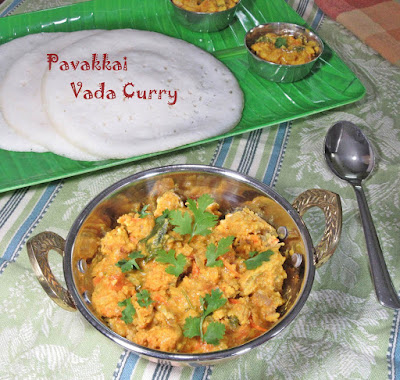Vada curry is one of
my favourite side dish for dosa but unfortunately never thought of making it at
home. My Mom used to do it with leftover masala vada. This time I wanted to do
it from the scratch. When I thought of adding
vegetables to make it healthier, the vegetable that came to my mind was
pavakkai / bitter gourd, the most nutritious vegetable people rarely eat
because of its bitterness.
People do add salt to
chopped raw pavakkai and squeeze the water out before cooking to reduce the
bitterness. Doing so, reduces not only the bitterness but also the nutrients present
in them. Instead, cooking pavakkai with tamarind paste will reduce the
bitterness. In this recipe I used carrots for added sweetness and also coconut
almond paste for more natural sweetness and richness.
I steam cooked the
vada instead of deep frying them. It's a great side dish not only for idli and
dosa but also goes good with chapatti. Pavakkai / bitter gourd has lots of
health benefits.
Pavakkai Vada Curry / Bitter gourd vada curry
No. of Serving : 4
No. of Vada : 12
Ingredients
For Vada
Bengal gram - 1 cup
Pavakkai / bitter
gourd - 1 medium
Carrot - 1 small
Onion - 1 medium
Tamarind paste - 1
tbsp (thick paste)
Turmeric powder - 1/4
tsp
Red chilli - 2
Fennel seeds - 1/4
tsp
Salt to taste
For Curry
Cloves - 3
Cinnamon 1 inch size
stick - 2
Fennel seeds - 1 tsp
Bay leaf - 1
Curry leaves - few
Onion - 2 medium
Tomato - 3 medium
Ginger garlic paste -
1/2 tsp
Red chilli powder - 2
tsp
Turmeric powder - 1/4
tsp
Fennel powder - 1/4
tsp
Salt to taste
Coconut - 2 tbsp
Almond / cashew nut -
2 (optional)
Coriander leaves -
few finely chopped
Preparation
Method
For the vada
1. Soak bengal gram
for 3 hrs.
2. Grind the soaked bengal
gram to a coarse paste with fennel seeds, red chilli, salt, turmeric powder and
tamarind paste. Adding tamarind paste when cooking pavakkai / bitter gourd will
reduce the bitterness of the gourd.
3. To the ground
mixture add finely chopped pavakkai / bitter gourd, grated carrot and finely
chopped onion, mix well.
4. Grease idli mould
with oil and fill with the vada mixture, steam it for 15 minutes.
5. Cool the vadas and
break them into small pieces.
For the Curry
1. Add almonds to
boiling water and remove the skin off. Grind it to a smooth thick paste with
coconut and keep aside. You can also use cashew nut instead of almond.
2. In a kadai, heat
oil and add cloves, cinnamon, fennel seeds and bay leaf.
3. When the fennel
seeds begin to crackle, add the curry leaves.
4. Then add finely
chopped onions and sauté till the onions turn translucent.
5. Then add ginger
garlic paste and sauté till the raw smell goes and a nice aroma comes.
6. Add chopped
tomatoes, add required salt and cook till the tomatoes are done.
7. Add chilli powder,
turmeric powder and fennel powder and sauté till the raw smell of turmeric
goes.
8. Add the ground
coconut almond paste, add 2 cups of water and bring to a boil, simmer the flame
and let it cook for 10 minutes. Do not cover the kadai with a lid.
9. Turn off the stove
and add the broken vada pieces and coriander leaves and mix well.
10. Can be served
with set dosa, idli, kal dosa, idiyappam and uthappam.
11. Can be served
with chapatti too.
Notes:
- Adding tamarind paste in vada will reduce the bitterness of pavakkai.
- Adding coconut almond paste will reduce the bitterness too.
- I added carrot for the extra sweetness.
- People do add salt to chopped raw pavakkai and squeeze the water out before cooking to reduce the bitterness. Doing so, reduces not only the bitterness but also the nutrients present in them.
- It tasted delicious and the presence of pavakkai in the vada was not noticeable in taste. You will not know that there is bitter gourd unless informed. Meaning to say, it was not bitter.
- When cooking, after adding coconut paste or coconut milk do not cover the vessel with the lid, coconut will curdle when cooked with the lid on.


No comments:
Post a Comment